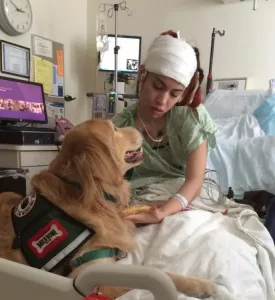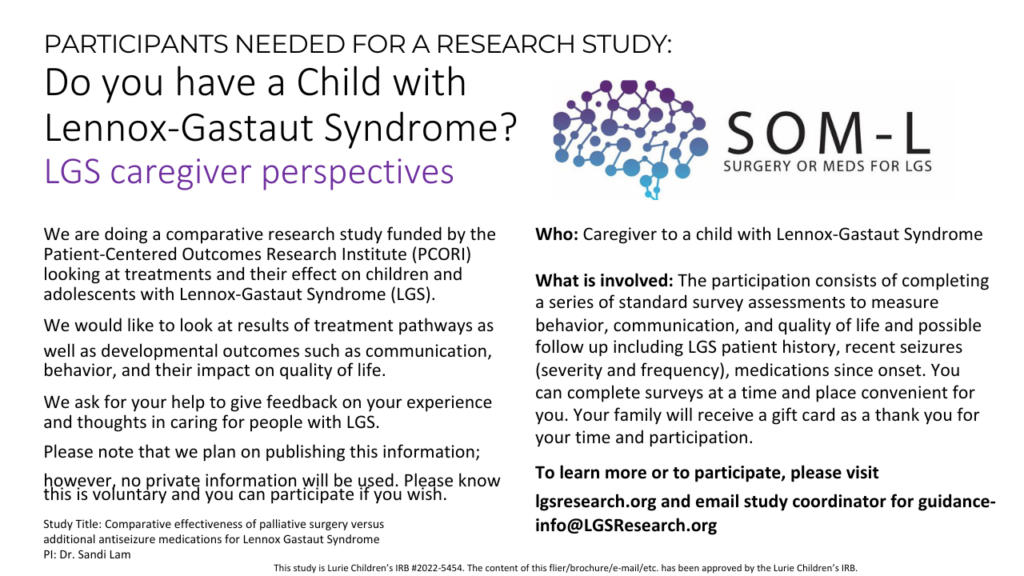 Lennox-Gastaut Syndrome (LGS) has no cure. Although current treatments may help reduce the number of seizures, none are expected to eliminate them entirely; these treatments are palliative. The main treatments include anti-seizure medications and some surgical approaches.
Lennox-Gastaut Syndrome (LGS) has no cure. Although current treatments may help reduce the number of seizures, none are expected to eliminate them entirely; these treatments are palliative. The main treatments include anti-seizure medications and some surgical approaches.
While both types of treatment (medications and surgeries) produce some benefits by reducing how often the seizures occur, both also have some risks. Most patients with LGS take several anti-seizure medicines at a time, which can produce moderate to severe side effects. Surgeries can also have associated risks and are additionally stressful for parents and family members.
Currently, there is no strong evidence to support parents and physicians in deciding which type of treatment (more medicines or surgery) will be most successful for a child with LGS, and whether one or the other approach may lessen the toll that seizures take on a child’s development and ability to function.
In this study, the research team is comparing outcomes among children with LGS (up to age 25) who receive medicine or surgery. The team is comparing healthcare use, behavior, and physical function between children in these two groups.
The results from this study will help parents and providers make more informed choices about treatment for children with LGS and will highlight areas for improvement in providing the best possible health care for this severe, lifelong disorder.
This study is in progress and actively recruiting.
For more information, visit the Surgery or Meds LGS Research Study website.
To participate, please email the Study Coordinator at info@LGSResearch.org.
Background and Significance: Lennox-Gastaut Syndrome (LGS) is a rare developmental-epileptic encephalopathy characterized by life-long refractory seizures which result in frequent utilization of emergency healthcare resources and also contribute to the severe developmental and functional impairment ubiquitously seen in affected patients. Current treatment pathways are the addition of anti-seizure medication treatment or palliative surgical procedures (including neurostimulation), both of which have strong evidence supporting their effectiveness in reducing seizure frequency, but without cures. No evidence exists about the comparative effectiveness of these two pathways. Until such evidence is developed, parents and physicians will continue to struggle with difficult and daunting decisions about whether to add anti-seizure medications or to pursue palliative surgery, and when to do so.
Study Aims: Determine the comparative effectiveness of adding palliative surgery versus adding an LGS-approved medication
- Aim 1a - for decreasing utilization of seizure-related emergency health care and
- Aim 1b - for limiting the impairment of functional abilities.
- Aim 2 - Describe the frequency and patterns of utilization of the two therapy pathways at 18 PCORnet sites for variation over time and across sites as well as by patient features - age, medical fragility, race, ethnicity, and insurance type.
In addressing these aims, the study will assess and improve PCORnet infrastructure and will enhance methods for future studies of LGS and other rare epilepsies.
Study Description:
- Aim 1a - Observational retrospective cohort study of emergency health-care utilization and
- Aim 1b - cross sectional study of the impact of treatment pathways on functional outcomes.
- Aim 2 - Retrospective open cohort study of frequency and patterns (by race, ethnicity, insurance, age) of utilization of the two treatment pathways.
PCORnet®, the National Patient-Centered Clinical Research Network, aims to improve the nation’s capacity to conduct health research by creating a large, highly representative network for conducting clinical outcomes research. In 2020, PCORI launched an initiative on Conducting Rare Disease Research using PCORnet to answer important questions about the treatment and management of rare diseases or conditions. The initiative funded this research project and others.
Updated 04/08/24

